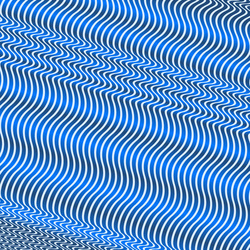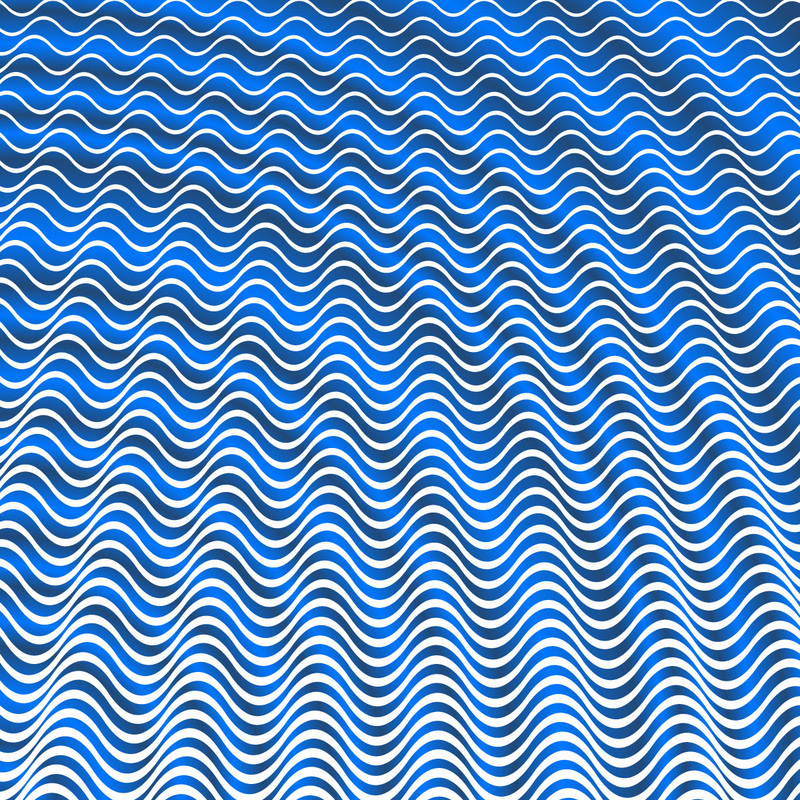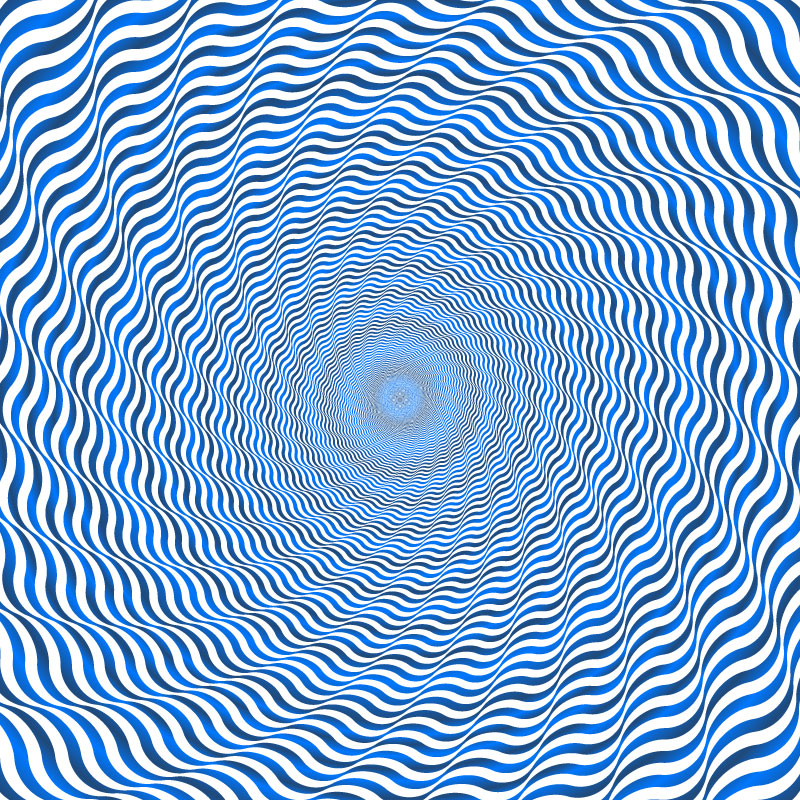FLOW
Exhibition
January 28 - March 18, 2016, Northcutt Steele Gallery, MSU Billings
HOME EXHIBITION VOICES OF THE RIVER SYMPOSIUM MIXING OIL & WATER FILM NIGHT WORDS ON WATER: POETRY & JAZZ IN CONCERT LIVING IN HARMONY ON THE YELLOWSTONE FILM
YOUTH OUTREACH READING AREAS YELLOWSTONE RIVER CUMULATIVE EFFECTS ANALYSIS MORE
YOUTH OUTREACH READING AREAS YELLOWSTONE RIVER CUMULATIVE EFFECTS ANALYSIS MORE
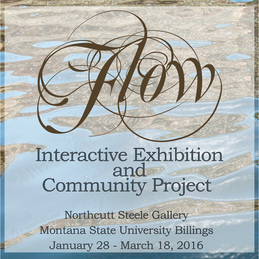
Flow was a socially-engaged project where the exhibition of art and installations set the framework and jumping off point for community conversations around water issues, rights and usage during multiple events. Sherri Cornett, with gallery director Dr. Leanne Gilbertson, created opportunities for community interaction, where the gallery was set up as a laboratory - a space for experimentation, dialogue and collaboration. With the exhibition and events, viewers, participants, artists, river users, and civic leaders were encouraged to think outside their own understanding and establish a more comprehensive and informed perspective about how water affects our lives and livelihoods. .
This exhibition highlighted Sherri Cornett's Grottoes Series (13 wall-mounted, mixed media, 3D sculptures including video meditations on water). The goal of her installation is to create a backdrop for conversations about water rights and conservation - where the sculptures and their videos are visual reminders of water as common ground. Additional juried artworks and installations by Karin Calabrese, Michelle Dyk/Peter Tolton/Luke Kestner, Tabetha Rindahl, Stephanie Slavin/Joel Miller, Patrick Williams and Dylan Woods further encourage viewers to consider the role of water in their lives.
The project commissioned "Living in Harmony on the Yellowstone" - a video interpretation of Yellowstone River Cultural Inventory by Bonny Beth Luhman and Ariel Grossfield
Area K-8 students created 5 x 7 inch water-themed panels which will be on display in the Outer Gallery. MSU Billings Art Education students worked with the Girls Scouts of Montana and Wyoming and the Boys & Girls Club of Billings and Will James Middle School. Please see Youth Outreach page.
This exhibition highlighted Sherri Cornett's Grottoes Series (13 wall-mounted, mixed media, 3D sculptures including video meditations on water). The goal of her installation is to create a backdrop for conversations about water rights and conservation - where the sculptures and their videos are visual reminders of water as common ground. Additional juried artworks and installations by Karin Calabrese, Michelle Dyk/Peter Tolton/Luke Kestner, Tabetha Rindahl, Stephanie Slavin/Joel Miller, Patrick Williams and Dylan Woods further encourage viewers to consider the role of water in their lives.
The project commissioned "Living in Harmony on the Yellowstone" - a video interpretation of Yellowstone River Cultural Inventory by Bonny Beth Luhman and Ariel Grossfield
Area K-8 students created 5 x 7 inch water-themed panels which will be on display in the Outer Gallery. MSU Billings Art Education students worked with the Girls Scouts of Montana and Wyoming and the Boys & Girls Club of Billings and Will James Middle School. Please see Youth Outreach page.
|
SHERRI CORNETT'S GROTTOES
|
LIVING IN HARMONY ON THE YELLOWSTONE
Bonny Beth Leah Luhman and Ariel Rebecca Grosfield |
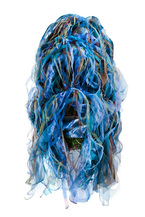
CASCADES GROTTO
38 x 22 x 15 inches 2012 steel, fabric, wire, video screen, paper mache', recycled glass chips, paint, moss The video contains clips from the Clark's Fork Canyon and Firehole Falls/Yellowstone Park in Wyoming, Basin Creek and Crazy Creek Falls in Montana 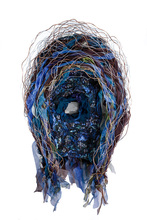
EFFERVESCENCE GROTTO
44 x 28 x 22 inches 2010 Steel, steel & copper wire, fabric, paper mache', glass cabochons, video screen, paint The video in the interior of this grotto includes footage from Basin Lakes Falls, Boiling River Hot Pots, Clark's Fork, Lake Fork, Red Lodge Creek, South Fork Grove Creek, and West Fork. 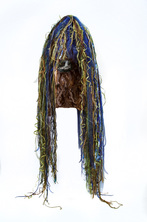
FALLING WATER GROTTO
61 x 22 x 15 inches 2015 welded steel, rope, ribbon, fabric, brown paper, plastic tape, raffia, video screen This video contains clips from Basin Falls, Stillwater Canyon, Vernal Falls, Holland Falls 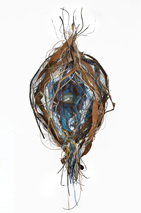
FLOWING STREAMS CHRYSALIS
55 x 27 x 15 inches 2010 steel, fabric, wire, electrical cord, video screen, ribbon This video contains clips of the Clark's Fork (WY), Boiling River Hot Lake Fork Creek/Beartooth Mountains (MT), Red Lodge Creek/Beartooth Mountains (MT), Rock Creek/Beartooth Mountains (MT), West Fork/Beartooth Mountains (MT). 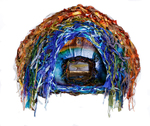
GEOTHERMAL GROTTO
2015 28 x 39 x 8 inches welded steel, wood, photograph, video screen,wire, fabric, painted canvas, trimmings, plastic string, raffia This video contains clips from the geothermal areas of Yellowstone National Park 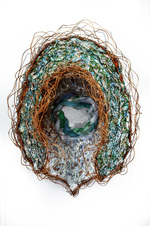
IRRIDESCENCE GROTTO
2012 37 x 28 x 18 inches Steel, copper wire, aluminum foil, aluminum sheeting shards, fabric, video screen, paint : The video in the interior of this grotto includes footage from Bahia de La Luna in Mexico, the Rhein River in Germany, the Big Horn Canyon, Silver Run Creek, Stillwater Creek and the Yellowstone River in Montana 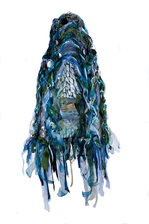
REFLECTIONS GROTTO
45 x 20 x 9 inches 2015 welded steel, glass, aluminum, video screen, wire, fabric, trimmings 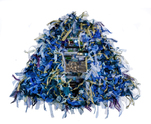
REFRACTIONS GROTTO
33 x 40 x 9 inches 2015 welded steel,wood, glass, fabric, wire, video screen 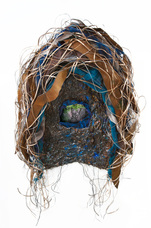
RIPPLES GROTTO
44 x 26 x 15 inches steel, copper, paper maché, fabric, digital video screen with cord, wire, paint The video includes clips from the Red Lodge Creek, Rock Creek, West Fork in the Beartooth Mountains. 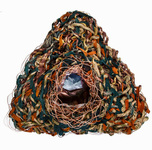
RUSHING WATER GROTTO
34 x 38 x 22 inches 2011 steel, video screen, copper wire, rope, vinyl This video contains footage from the Clark's Fork in Wyoming, the Boulder River at Camp Miminagish, the Boulder River at Natural Bridge, Rock Creek, the Yellowstone River near south of the bridge at Tower-Roosevelt. 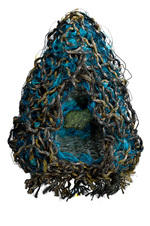
SHADES OF TURQUOISE GROTTO
42 x 29 x 16 inches 2011 steel, rope, video screen, wire, fabric, suede, silicone The video in the interior of this grotto contains footage from Stillwater Canyon, Yellowstone Park, Yellowstone River, Clark's Fork. 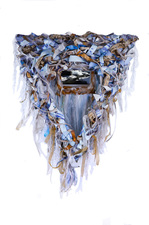
WINTER GROTTO
42 x 30 x 8 inches 2015 welded steel, video screen, bark, photographs, suede, fabric, wire, trimmings This video contains clips from the Yellowstone River and West Fork of Rock Creek 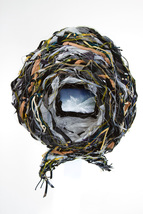
YELLOWSTONE RIVER GROTTO
35 x 24 x 15 inches 2012 recycled steel rod, video screen, steel wire, recycled steel mesh, recycled bicycle tires, recycled nylon rope, recycled guitar strings, balloons, nylon hose, trash bags, transparent tape, electrical tape, recycled shower curtain, recycled nylon yarn, recycled VHS tape, wax paper, plastic wrap, organza ribbon, nylon undergarments The Montana Constitution guarantees a pollution-free, healthful environment, yet three oil refineries sit on the banks of the Yellowstone River, a symbol of this treasured environment. On July 1, 2011, an Exxon Mobil pipeline broke under the river, releasing 750-1000 barrels of oil, one-half of which would have been made into petroleum products such as those in this piece. This video includes footage of the Yellowstone River near its source in Yellowstone Park, as it goes through Gardiner, Montana at the northeast entrance to the park, in Yankee Jim Canyon, at Pray, Montana, south of Livingston, Montana and in Billings, Montana. |
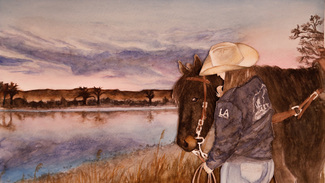 Video still Video still
Digital Media
6 minutes This film was inspired by the Yellowstone River Cultural Inventory (2008), which is part of the 16 year Cumulative Effects Analysis (CEA). Copies of the Recommended Practices, which constitute a small portion of that study, are available for viewing in the gallery. In Living in Harmony on the Yellowstone, all creatures, big and small, work together to create an environment sustainable for co-existence. This short film represents perspectives of different fish, including catfish, minnows, and the pre-historic Pallid Sturgeon that is unique to the Yellowstone! The film also represents mammals such as beavers, birds, and elk, along with the perspectives of people from the five different River User Groups mentioned in the study which include: a recreationalist/fisherman, agriculturalist/farmer, residentialist/rancher, a civic leader, and a Native American. The film offers an opportunity to contemplate the significance of the river—how it affects everyone and everything that lives next to it, and how we must all live in harmony. Dr. Susan Gilbertz (Director of the Environmental Studies Program, MSUB) and colleagues conducted the Yellowstone River Cultural Inventory (2006) (full cultural study accessible here). JURIED ARTWORKS AND INSTALLATIONS
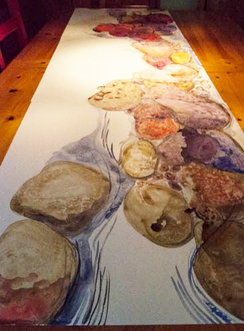 Work in Progress Work in Progress
KARIN CALABRESE
"The Pleasure of Water" 82 x 20 inches Watercolor on Yupo Growing up on the east coast, the ocean, lakes and rivers have been an important part of my life. While water is crucial to the biological needs to each living organism, water also holds power to bring joy, peace and plain recreational fun. I recall some of my best childhood memories are water related, whether a vacation to the shore or a lake or simply cooling off under a summer sprinkler. These experiences spur me to consider how a person relates and engages with water. I have used watercolor on yupo to start a discourse of how water touches our bodies while referencing the effect on the natural world. After a vacation to Flathead Lake and seeing the beauty of river rocks, I have painted the rocks in the intense color as they sit in the water and then by process I have added water to show the beauty of full immersing, running of the river, and the sprinkling of rain. I have used 3 sheets of yupo placed as a series each being 26x20. They remain unframed to keep a natural undefined space, which is not contained, since water is always flowing. Yupo being very responsive to water makes beautiful reticulations which reflects the beauty of the Montana waters that we enjoy. 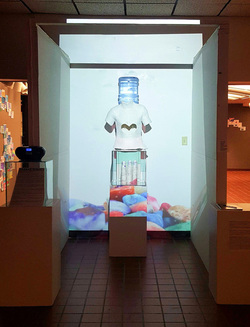
MICHELLE DYK:Concept and design
PETER TOLTON: Video Element LUKE KESTNER: Musical Element “Immersion” This site-specific, interactive installation was created specifically for the Flow Exhibition as a reminder of what water means to us on a basic physical level. This is a space to drink, think about, & discuss water. "On 28 July 2010, through Resolution 64/292, the United Nations General Assembly explicitly recognized the human right to water and sanitation and acknowledged that clean drinking water and sanitation are essential to the realization of all human rights." Human bodies need water to function. According to the Mayo Clinic our bodies are made up of approximately 60% water. We must drink enough to keep our bodies from becoming dehydrated and eventually dying. Water also functions as our main way of keeping ourselves and our environments clean, Whether we are drinking it, or bathing in it, water keeps us healthy in a myriad of ways Please step into this installation, hydrate, and contemplate our relationship with water. We’ve layered visual and audio elements to be experienced while acquiring drinking water. Bathe in beautiful imagery of water captured on video by Peter Tolton. You will also hear Luke Kestner’s musical stylings inspired by the visuals. As you experience water, physically, visually, and through music please take some time to consider why water is a basic human right. Without water, we die. 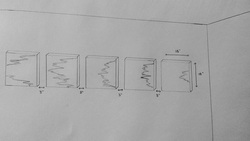 Proposal Sketch Proposal Sketch
TABETHA RINDAHL
"Taken for Granted" 5 paintings/ 18 x 18 inches each Materials: Encaustic and oil sticks on wood panels Price: $150 each ($650 for all) Water is one of the prime elements responsible for life on earth. It circulates through the land just as it does through our bodies. Water is essential for all living things on Earth; it is the substance of life. This series of five paintings depicts the rapid increase of water usage from 1990 to 2020. The series is created as representational paintings using statistical data collected pertaining to the increased water usage statewide in Montana since 1990. According to the United States Geological Survey, the domestic self-supplied groundwater withdrawal amount was 15.05 million gallons/day in 1990. This amount increased to 16.60 million gallons/day in 1995, 21.77 million gallons/day in 2000, and 22.42 million gallons/day in 2005. There is expected to be about 27 million gallons/day of groundwater withdrawn in 2020. 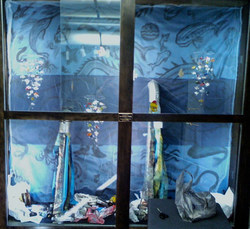 During installation During installation
STEPHANIE SLAVIN andJOEL MILLER
"Contaminating Life" 94 x 84 x 14 inches fabric, acrylic, garbage, metal piping with rust on it, and aluminum fish cut from cans The idea of the installation is to create a beautiful aquatic life scene and then show how man is contaminating it and ruining it. Fabric will be the water that is flowing in the backdrop and coming out of the rusted pipes to show fluidity. While the metal piping comes from old air ducts, that have since been replaced and have been sitting and rusting away. The pipes will be mounted to the wall and cut through the fabric backdrop as if they were disrupting the flow of life. The aluminum fish are cut from cans to make a show of the life forms being contaminated to the point of where they themselves are almost being turned into these garbage pieces. The fish will be strung up and hung from the top of the display in a clustered. PATRICK WILLIAMS
"Ripple Triptych 1", Ripple Triptych 2", Ripple Triptych 3" 16 x 16 inches Digital sublimation print on metal Water is almost always in motion; sometimes in obvious ways, and sometimes in subtle ones. Building on visual concepts pioneered in the Op Art movement in the 1960s, particularly Bridget Riley's Current, I've created images that combine Op Art visual styles with mathematical musings on wave interference — the patterns created when multiple sets of asynchronous waves intersect, like the ripples in water. The motion propagates through water in waves, of varying wavelengths and amplitudes. As these waves intersect, their peaks and valleys sometimes amplify each other and sometimes cancel each other out. Unless the waves have identical wavelengths, the alternating amplification and nullification of the intersections creates unique patterns; the interference patterns in the waves are analogous to human society: sometimes we work together, sometimes we work against each other, and sometimes the combination of the two creates something new and different, a synergy that's greater than the sum of its parts.  Voss-Washing Voss-Washing
DYLAN WOODS
"Voss-Washing" .Gif Voss Water is the quintessential example of gratuitous lifestyle branding and advertisement. Artesian bottled waters represent a consumer demand that is completely superficial and exists in blatant disregard of the reality of water scarcity and inequality. In a society of rampant commodity fetishism we are so concerned with surface and image that we have elevated life's biggest necessity into a luxury item, packaged and designed like the newest Apple product. The sheer ostentation of Voss Water —or any water re-purposed as a status symbol— speaks volumes about what we value and how we spend our money. While Voss has raised $750,000 to help provide clean water to those in need, in a similar fashion to “greenwashing”, they have also advertised these good deeds and profited millions from selling what is the same public tap water in Vatnestrom, Norway, as a premier lifestyle choice. |

